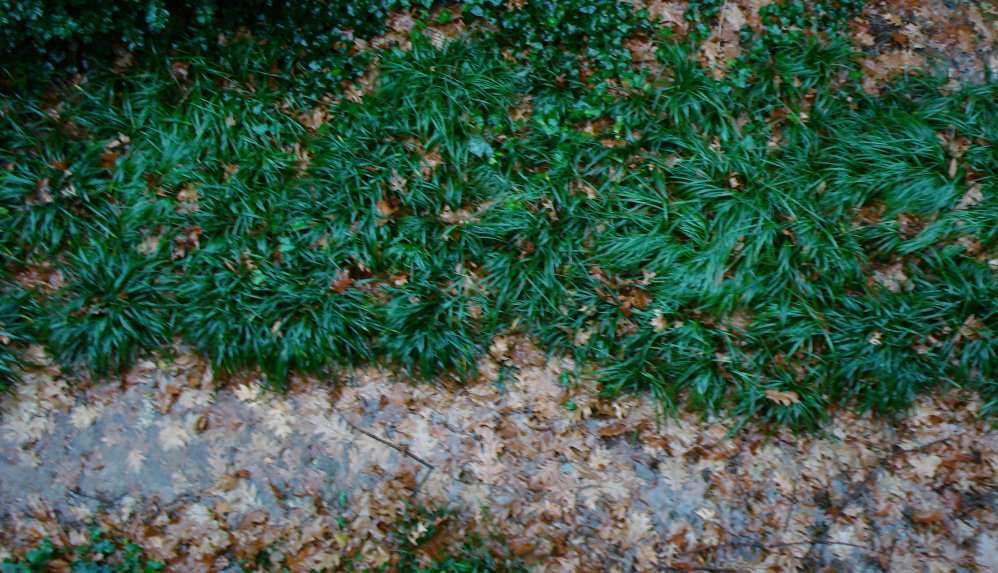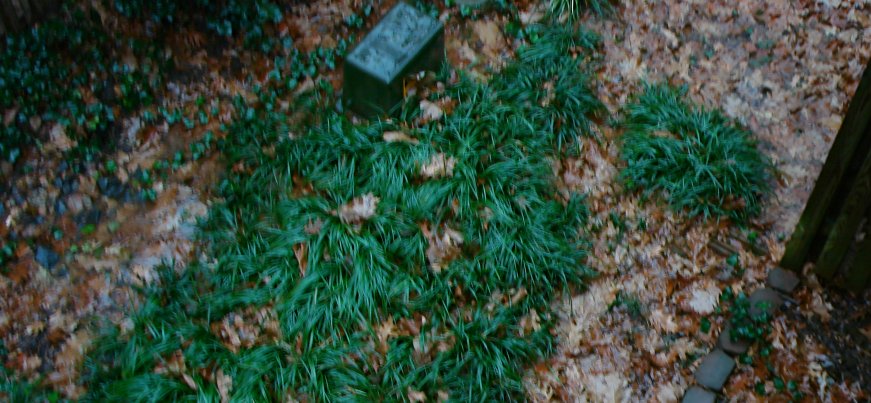
Up until this year the landscapers around our housing complex have been busy with their noisy leaf blowers and stinky mowers, this year not so much. In fact, they more or less left the strip in back of our house alone and let the leaves pile up. This is very good and you can see the evidence of that in the pictures.
We got a lot of rain this season and the ground is saturated. This has always meant erosion the water runs rapidly off the roofs of the houses and down the narrow channel in back. The shadows of the houses and trees make it hard to grow grass and grass has trouble standing up to the fast water flow. (In the pictures you see the lilyturf and ivy I planted a couple years ago to at least hold the ground in back of our house. That does well in this environment, but in back of the other houses there is mostly just dirt.) W/o the leaves on the ground, the water running off is full of silt, but the leaves both protect the ground and absorb some of the water.
Storm water is a big and growing problem in Fairfax County because of all the hard surfaces. It erodes the stream beds and messes up the Chesapeake Bay. Sometimes our excessive commitment to tidiness exacerbates the problem. Most homeowners are unenthusiastic about water standing near their houses and they quickly sweep up leaves. This “virtue” is hard on the water systems.
See the utility box in the picture below. Before I put in that ground cover, there was a big rut almost a foot deep running along both sides of that thing. The plants have raised the ground level, by trapping silt. They will completely cover the ground by the end of next year. If the whole back was covered in plants most storm water would soak in and very little would run off at all.

The lesson I take is that you are often better off letting things alone. There have been lots of proposals to try to make the grass grow (impossible in the shade), put in drains (expensive, bad for the environment because it accelerates runoff), put in rocks (ditto) or mulch the whole thing (not bad, but mulch tends to wash away a lot easier than leaves), but the best thing to do may be almost nothing.
The best thing to do would be to put in some kind of ground cover, actually make the whole thing into a long rain garden. (I wrote about this kind of thing before) In time, it would establish a strong root system that would both trap sediment and help water soak in. It would be a little work at first but then very low maintenance. It took me a day to put in that in the pictures ground cover and I got it all free just by taking what Chrissy thinned out from the front of the house, but I can’t and wouldn’t be allowed to put it in back of the other sixteen houses along this way. So the next best thing to do is nothing, or maybe just resist any attempts to “fix” the problem at home owner association meetings, unless we are talking about rain gardens. Maybe I should develop a proposal for a rain garden. I volunteered to help start a landscape committee a couple months ago, but still have no interest or authorization from the board. I suppose I should bring it up again.
So absent that, sometimes doing nothing, or at least not much is the best thing. All I know is that I have been watching this water flow for a ten years, trying with limited success to stop the dirt from running off. Now the lackadaisical response to the fallen leaves have done the job for me.
